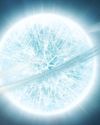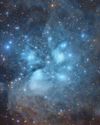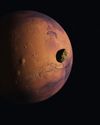
When we think about planets, a star usually comes as part of the package. After all, where would Earth be without the Sun? Imagine Luke Skywalker’s home planet of Tatooine without its twin suns, or Superman without Rao, the red supergiant around which Krypton spun. Yet you’d be wrong to imagine that planets are never starless. Astronomers have already found swarms of rogue planets – worlds wandering the open chasm of space alone.
As far as we know, planets always start off with stars. They are the leftover fragments from star formation, the offcuts that you’d throw away in a skip if you were building a house. A cloud of gas and dust that was otherwise minding its own business may begin to contract if it’s hit by a shock wave from an exploding star. As the cloud compresses, gravity takes over and bundles it into an ever-smaller space until fledgling stars ignite inside.
The shrinking cloud begins to spin faster and faster, flinging leftover gas and dust into discs around new stars. Gravity continues its work here, too. Dust grains merge into lumps the size of golf balls, which continue to snowball until they reach a kilometre or so across.
Astronomers call these planetary building blocks planetesimals. Close to the star they are made of metals – the only materials with high enough melting points to stay solid in the face of the inferno. Further out – beyond an imaginary boundary called the ice line – temperatures plummet below freezing and the planetesimals take the form of frigid lumps of water, ammonia and methane ices. That’s why we have rocky planets close to the Sun and ice giants the furthest out.
Bu hikaye All About Space dergisinin Issue 118 sayısından alınmıştır.
Start your 7-day Magzter GOLD free trial to access thousands of curated premium stories, and 9,000+ magazines and newspapers.
Already a subscriber ? Giriş Yap
Bu hikaye All About Space dergisinin Issue 118 sayısından alınmıştır.
Start your 7-day Magzter GOLD free trial to access thousands of curated premium stories, and 9,000+ magazines and newspapers.
Already a subscriber? Giriş Yap

MYSTERIES OF THE UNI WHERE ARE ALL THE SPIRAL GALAXIES?
There are far fewer spiral galaxies than elliptical ones in the Supergalactic Plane, and scientists are keen to discover why

ZOMBIE STARS
+10 OTHER TERRIFYING SPACE OBJECTS

HOW TO BEAT LIGHT POLLUTION
Thought it was impossible to observe the wonders of the night sky from towns and cities? Think again. Follow our tips and tricks on successfully observing through sky glow

15 STUNNING STAR CLUSTERS
These beautiful stellar groupings are spattered across the cosmos

Eileen Collins "It was a difficult mission...we were the first to see Mir"
Having served as both the first female pilot and first female commander of NASA's Space Shuttle, Collins boosted the involvement of women in space exploration to a whole new level

MARS LEAKS FASTER WHEN IT'S CLOSER TO THE SUN
The Red Planet has lost enough water to space to form a global ocean hundreds of kilometres deep

FUTURE TECH KANKOH-MARU
This ambitious reusable spacecraft will be capable of taking 50 people to and from orbit

THE FINAL FRONTIER
Beyond the reach of the Sun is a fascinating region of the cosmos that were only just beginning to explore

A long-lost moon could explain Mars' weird shape and extreme terrain
A long-lost moon could explain why Mars is so different from the other rocky planets in the Solar System. Today Mars has two tiny moons.

A sprinkling of cosmic dust may have helped kick-start life on Earth
Cosmic dust may have helped kick-start life on Earth. New findings challenge a widely held assumption that this wasn't a plausible explanation.